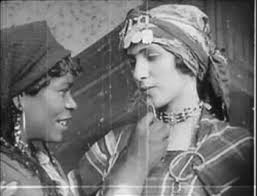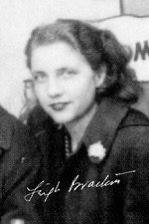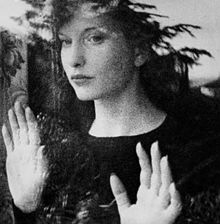Celebrating Women's History Month 2020
- Allison Michelle Morris
- Apr 2, 2020
- 29 min read
Updated: Sep 24, 2021
Since 2017, it's become a tradition of mine that, for the month of March, I research and post on social media about women in film history. Looking back at the years that I've been doing this, I can't help but see it as a celebration. So far, I have learned about and shared the stories of over 100 women in the film history. Some I knew about, some I had never heard of before, but all of their stories are equally valid and inspiring.
Among this year's group, there were Oscar winners, specific industry "firsts," and women who wore multiple hats to get the proverbial job done. I'm thankful for the female filmmakers who have come before me and to the women who are working hard to make a difference in the industry now, and am already looking forward to next years Women's History Month celebrations!
If you'd like to read more about the women I featured on social media throughout March, I've included a bio and their IMDB links down below.
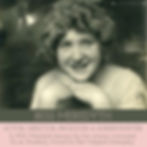
Bess Meredyth (1890-1969) started her career in entertainment at a local theatre as an organist and vaudeville comedienne as a teen. She moved to Hollywood in 1911, after working as an extra for D.W. Griffith’s Biograph Studios, and quickly began writing scenarios on a freelance basis to supplement her income.
After starting a family, from 1921-1928, Meredyth resumed her career in Hollywood, accumulating more than 125 writing credits, working in succession for Metro-Goldwyn-Mayer, Warner Brothers, Goldwyn Productions, First National Pictures, and Columbia Pictures. Most famously during this time, MGM sent her to Italy in 1924 to help rescue the failing production of Ben-Hur (1925). One of its founding members, in 1930, Meredyth became the first woman nominated for an Academy Award for Best Adapted Screenplay for A Woman of Affairs (1928) and Wonders of Women (1929).

Sarah Yeiser Mason (1896-1980) began working in films in 1917 when she was allegedly "discovered" by actor Douglas Fairbanks while on location shooting the film Headin’ South. As the story goes, she started working for Fairbanks’ acting company the next day.
Eventually, Yeiser Mason started working as a "continuity girl," a position that preceded today’s script supervisor. Her first film credit was for Allan Dwan’s Arizona (1918); this credit makes her one of the industry’s first continuity writers, if not the first.
Yeiser Mason wrote original scenarios and screenplays for studios MGM, Paramount and Columbia, and created and adapted stories for early film stars like ZaSu Pitts, Elaine Hammerstein, and Owen Moore. Yeiser Mason is best known for the films Bright Skies (1920), The Heart of Twenty (1920), Backstage (1927), The Broadway Melody (1929), Little Women (1933), The Age of Innocence (1934), Magnificent Obsession (1935), and Golden Boy (1939).
In 1930, The Broadway Melody won the Academy Award for Best Picture and in 1934, Little Women won the Academy Award for Best Adapted Screenplay, making Yeiser Mason the first woman to win the award.

Eslanda “Essie” Cardozo Goode Robeson (1895-1965) led a unique and full life, working both within the entertainment industry and as a civil rights activist.
In 1920, she met activist, actor, and singer Paul Robeson, and they married a year later. Eslanda gave up her intentions to pursue medicine in 1925 and supported her husband as his business and talent manager. Robeson also followed her own acting career, most notably appearing as Adah in Borderline (1930), an avant-garde silent film directed by Kenneth MacPherson. The film revolves around an inter-racial love triangle and its effects on the community. As an author, Robeson wrote her first book, a biography of her husband Paul Robeson, Negro in 1930. It was well-received by critics Harry Hanson and W.E.B. du Bois. Robeson completed her second book, African Journey, in 1946, the same year she received her Ph.D. in anthropology from the Hartford Seminary. Her third book, American Argument, was published in 1949, and was a collection of dialogues and comments that allowed Robeson an opportunity to speak on society, politics, gender role, and race relations.

Jenny Gilbertson (1902-1990) was inspired to learn about filmmaking in 1929 after watching a screening of an amateur film about the Scottish Loch Lomond in London. She immediately purchased a 16mm Cine-Kodak camera and taught herself the fundamentals of cinematography while shooting footage of squirrels in Kensington Gardens and barges on the River Thames.
As a documentary filmmaker in Scotland and Canada, all of Gilbertson’s films focused on embracing nature, farming life, fishing, families that did such activities and anything that captured the environment she was in. Jenny lectured all over the world about her nature films, and took a hiatus from filmmaking to teach at a local Shetland primary school for two decades before making one of her most influential films, 1967’s People of Many Lands.

Yin Mingzhu (1904-1989), also known professionally as Pearl Ing, started her career as a model and society girl. At seventeen, Yin met director Dan Duyu at a party and the pair began working together. She went on to star in about half of the 30 movies Dan directed from 1922-1952. In 1922, Yin starred in Sea Oath, making her the first woman to play the leading role in a film made in Shanghai—the earliest center of Chinese filmmaking. Yin and Dan married in 1926, and Yin gradually started working behind the scenes as a production coordinator and investor with the Shanghai Shadow Play Company. When the Shadow Play Company was destroyed during the Second Sino-Japanese War in 1932, Yin invested in and established the Shanghai Talkie Company in 1934. As an actress, Yin is best known for Some Girl (1925), The Cave of the Silken Web (1927), A Dream of Red Mansions (1928), Oriental Night (1930), Golden Age (1933), and Peach-Blossom Dream (1934). Unfortunately, many of Yin’s films are thought to lost or destroyed, except for an original copy of The Cave of the Silken Web, which was rediscovered in Norway in 2011.

Haydée Chikly (1906-1998), considered the first professional actress and screenwriter in Africa, stated at a young age: “I do not want a quiet and easy life, I want to fight, strive and struggle.”
Born in Tunisia, Africa, Chikly was encouraged to pursue her interests in the arts from her mother, a musician, and her father, an experimental filmmaker. Widely considered the first narrative film made in Tunisia and the first indigenous North African film production, Albert Samama Chikly directed his daughter in her first starring role, a short film she wrote called Zohra (1922).
Chikly’s next film was another silent drama, “Ain el-Ghezal” [The Girl from Carthage] (1924), a Tunisian-inspired “Romeo and Juliet.” She wrote the script "to show how badly women were treated when they were just sold off with an arranged marriage into a man’s world.” Chikly also partially edited “Ain el-Ghezal” as a film cutter and colorist. Unfortunately, in the early 1980s, the script for “Ain Ghezal” was removed from the family archives when the Ministry of Tunisian Culture planned to open a cinema museum, and the script was lost.

Hannah Weinstein (1911-1984), born and raised in New York, NY, studied journalism at New York University as a young woman. After graduating in 1927, she went to work for The New York Herald Tribune. Ten years later, she left The Tribune to join the Fiorello H. La Guardia mayoral campaign. After working for the La Guardia reelection campaign, she was a speech writer for President Franklin Delano Roosevelt.
In the wake of the McCarthy era, Weinstein moved to Paris in 1950 and then London in 1952, where she started Sapphire Films, a film and television production company that produced scripts by blacklisted Hollywood writers, including series episodes written (under a pseudonym) by Ring Lardner Jr. and Adrian Scott. Weinstein herself was designated a “concealed Communist” by the F.B.I. Weinstein worked in England before returning to the United States in 1962; during this ten year period Sapphire Films made 435 television films and series, including the hits Robin Hood (1955-1960), The Four Just Men (1959-1960) and Colonel March of Scotland Yard (1954-1956).
In 1971, along with Ossie Davis, Rita Moreno, Diana Sands, and James Earl Jones, Weinstein founded Third World Cinema. The production company’s goals were “to train people of color for work in the film industry and to make feature films from a minority perspective.” With Third World Cinema, Weinstein produced Claudine (1974), Greased Lightning (1977), and Stir Crazy (1980).

Born in Melbourne, Australia, Peggy Glanville-Hicks (1912-1990) pursued music from a young age and began composing at the age of 7. By the time she was 15 years old, she started studying composition with Fritz Hart and piano with Waldemar Seidel.
She attended the Royal College of Music in London from 1931-1936, studying piano, conducting, and composition. In 1938, Glanville-Hicks became the first Australian composer whose work was performed at an International Society for Contemporary Music (ISCM) Festival.
From 1949-1958 Glanville-Hicks served as a critic for the New York Herald Tribune. At the same time, she was still composing and was the musical director at the Museum of Modern Art in New York. In 1960, Glanville-Hicks composed the score for Shirley Clarke’s UNICEF-produced documentary A Scary Time. Unfortunately, the final piece was so unsettling, UNICEF deemed it too upsetting and never used it.
After her death in 1990, Glanville-Hicks’ will established the Peggy Glanville-Hicks Composers’ House in her home in Paddington, Sydney, as a residency for Australian and overseas composers. The organization New Music Network established the Peggy Glanville-Hicks Address in her honor in 1999.

Born in San Francisco, CA, Esther Eng (1914-1970) spent her childhood in the Cantonese Opera Houses and cinemas popular in Chinatown. When she was 19, after seeing the Chinese nationalist film The Battle of Shanghai, Eng’s father and his business partners were inspired to create Kwong Ngai Talking Pictures Company (a.k.a. Cathay Pictures Ltd.). Eng quickly became a producer at the company.
Eng’s first film credit was co-producing Heartaches (1935), a melodrama depicting the Chinese war effort. A Los Angeles Times review acknowledged Heartaches as the “first oriental production with sound finished in Hollywood.” In June of 1936, Eng and actress Wai Kim Fong traveled to Hong Kong to recruit talent for her next project. Eng decided to register Kwong Ngai Talking Pictures in Hong Kong, cast Wai Kim Fong as the lead, and directed the film herself. National Heroine (1937) was a massive success and praised for its portrayal of a heroine fighting alongside male comrades for the sake of China. The Cantonese Women’s Association gave Eng an award for the film’s patriotic message and promotion of positive images of women. While in Asia, Eng made four more social commentary films focused on female protagonists, including It’s a Women’s World (1939). It’s a Women’s World, also co-written by Eng, was advertised as the first Hong Kong produced film to feature an all-female cast of 36 actresses. After returning to the U.S., Eng spent several months in Hollywood learning about new developments in motion pictures before directing Golden Gate Girl (1941). Eng directed four more films from 1946-1961, but never attained the same level of success as she had overseas.

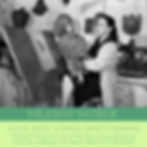
Milicent Patrick (1915-1978) studied at the Chouniard Art Institute from 1936-1939, where she focused on illustration and drawing. Patrick started working at Walt Disney Studios in 1939 in their all-female ink and paint department. By 1940, she was moved to the Animation and Effects department, where she became one of the first female animators at Disney. Her work as a color animator can be seen in four of the sequences in the film Fantasia. During her time at Disney, she also worked on the film Dumbo before leaving the studio in 1941. In 1947, while at Universal Studios for an acting gig, Patrick met Bud Westmore, head of the Universal’s makeup department, and showed him her sketches. Patrick became the first woman to work in a special effects makeup department, credited with contributing to makeups in Against All Flags (1952), It Came From Outer Space (1953), Sign of the Pagan (1954), This Island Earth (1955), and The Mole People (1956). In 1953, Patrick began designing the cowl piece for Gil-man in Creature from the Black Lagoon. During promotion for the film, she was sent on a press tour dubbed “The Beauty Who Created the Beast,” to discuss the creation of the creature. Westmore quickly changed it to “The Beauty Who Lives With the Beast,” to avoid citing Patrick as the creator of the Gill-man. When she returned to Los Angeles after the tour, Universal fired Patrick, letting her go due to Westmore’s jealousy over the attention she received. Unfortunately, Patrick never worked behind the scenes again. She spent the rest of her life as a "society woman" and portrait artist.

Dubbed the “Queen of Space Opera” for her contributions to the science-fiction genre, Leigh Brackett was the first woman shortlisted for the Hugo Award. Leigh Brackett discovered fantasy-science fiction by reading E.R. Burroughs’ The Gods of Mars when she was in the eighth grade, and began writing and submitting novels to editors in 1928 when she was just 13-years-old. Brackett sold her first story to the “pulp fiction” magazine Astounding in 1939 and published her first full-length novel, the mystery No Good from a Corpse, in 1944.
Despite science fiction being a male-dominated genre to the extent that both the profession and the content of the stories was more often than not anti-female, Brackett pursued the genre wholeheartedly and thrived. From 1939 to 1974, Brackett published more than 50 stories in more than 13 pulp magazines. She was so much a part of the scifi world that Brackett's fans adoringly named her the “Queen of Space Opera,” and her work would help shape the genre in the mid-20th century. Her success helped break down the gender bias in the science-fiction field.
In 1944, director Howard Hawks hired Brackett to work with William Faulkner to adapt Raymond Chandler’s short story Killer in the Rain for film. Hawks thought Brackett had the right “strong stuff” after reading one of her crime novels, thinking that she “wrote like a man.” Brackett later said, “[Hawks] was somewhat shaken when he discovered that it was Miss and not Mr. Brackett.” The Big Sleep (1946), starring Humphrey Bogart and Lauren Bacall, became one of Hawks’ most well-known films, and Brackett continued writing scripts—notably Rio Bravo (1959), Hatari! (1962), and The Long Goodbye (1973)—and turned in the first draft of The Empire Strikes Back just before she died in 1978.

Born Eleanora Solomonovna Derenkovsky in Kiev, Ukraine, Maya Deren survived the Russian Revolution and spent her childhood in Ukraine until 1922 when her family moved to Syracuse, NY.
Deren studied journalism at Syracuse University and New York University, graduating in 1936. While at NYU, she became interested in film and photography. Deren went on to study literature at Smith College and received her M.A. in 1939. After graduating, Deren became choreographer and anthropologist Katherine Dunham’s secretary in Los Angeles, CA.
In 1941, she met Alexander Hammid, a Czechoslovakian refugee who emigrated to the United States to work as a motion picture photographer for The March of Time newsreels. The two married in 1942, and it was during this time Deren changed her first name to Maya, the Sanskrit word for “illusion.” In 1943, Deren’s father died and left her a small inheritance with which she purchased a second-hand Bolex 16mm camera, which she and Hamid used to make the film Meshes in the Afternoon. Meshes of the Afternoon (1943), is one of the most influential experimental films in American cinema history. Deren went on to make several films of her own, including At Land (1944), A Study in Choreography for Camera (1945), and Ritual in Transfigured Time (1946), writing, producing, directing, editing, and photographing them with help from only one other person, Hella Heyman, her camerawoman.
In 1946, Deren published An Anagram of Art, Form, and Film and received a Guggenheim Fellowship for Creative Work in the Field of Motion Pictures. Deren was the first filmmaker to be awarded a Guggenheim fellowship. In 1947, Deren presented Meshes in the Afternoon at the Cannes Film Festival where it won the Grand Prix International in the category of 16mm Film, Experimental Class. It was the first time the award went to a film produced in the United States and the first time a female director was honored.

Shirley Clarke (1919-1997) was drawn to the arts at an early age—particularly dance—which her father and discouraged. It wasn’t until she attended college that she could dance, and trained under the Martha Graham technique, the Humphrey-Weidman technique, and the Hanya Holm method of modern dance.
Clarke started her artistic career as a dancer in the New York avant-garde modern dance movement, but in 1951, following a long recovery after the birth of her daughter, Clarke began rethinking her creative direction. Inspired by filmmakers like Maya Deren, Clarke began developing her own style of film dubbed "Cine-dance." Rather than documenting a dance as it exists on stage, Cine-dance can only exist on film.
In her first film Dance in the Sun (1953), Clarke adapted a piece of Daniel Nagrin’s choreography, and the New York Dance Film Society selected it as the best dance film of the year. In 1954 she started studying filmmaking with Hans Richter at the City College of New York; Clarke broke through the independent filmmaking scene in New York and became a member of the Independent Filmmakers of America in 1955. Clarke received an Academy Award nomination for Best Short Live Action for Skyscraper (1959) and won for Best Documentary for Robert Frost: A Lover's Quarrel With the World (1963). In 1961, Clarke signed the manifesto Statement for a New American Cinema, and in 1962, she co-founded The Film-Makers' Cooperative.
In 1961, Clarke directed her first feature film, The Connection, adapted from Jack Gelber’s play. Shot like a “faux-documentary,” the film follows a young filmmaker who attempts to film junkies waiting for their heroin dealer to arrive. The Connection was embroiled in a major censorship case as Clarke filed suit to be able to show the film in New York. She was initially denied a license because of the use of the word “shit” in the film and the case went to the New York State Court of Appeals, which she won.

Dorothea ”DeDe” Corothers Allen (1923-2010), nicknamed the “film editing doctor,” revolutionized imagery, sound, and pacing in American films, and is best known for editing classic films like The Hustler (1961), Bonnie and Clyde (1967), Dog Day Afternoon (1975), and Reds (1981).
Born in Cleveland, Oh, Allen moved to California to attend Scripps College in Claremont, CA in the 1940s. After graduation, she worked her way up as a production runner, a sound librarian, and then as an assistant film editor at Columbia Pictures. She edited commercial and industrial films before becoming a full-fledged feature film editor. After 16 years of working in Los Angeles without much recognition, Allen and her husband moved to New York, where she edited her first notable feature in 1959: Odds Against Tomorrow, directed by Robert Wise. One of Allen’s biggest impacts on American film and editing was her use of European techniques, particularly jump cuts. For example, in the ambush scene at the end of Bonnie and Clyde, Allen used about 50 cuts in one minute, slowing down and speeding up the action. Allen earned Academy Award nominations for her work on Dog Day Afternoon (1975), Reds (1981), and Wonder Boys (2000). She received the American Cinema Editors’ Career Achievement Award in 1994 and the Motion Picture Editors Guild’s Fellowship and Service Award in 2007. In 2012, the Motion Picture Editors Guild compiled a list of 75 of the best-edited films; three of Allen’s films made the List: Bonnie and Clyde, Dog Day Afternoon, and Reds. Only one editor—George Tomasini—has more films on this list.

Banned by the Czechoslovak government in the 1960s for her controversial and avant-garde work, Věra Chytilová (1929-2014) is best known for pioneering Czech cinema, particularly Czech New Wave.
Chytilová initially studied philosophy and architecture before pursuing the arts. She worked as a model and as a photo re-toucher before working as a clapper girl for the Barrandov Film Studios in Prague. She sought a recommendation from Barrandov Film Studios to study film production, but was denied. Undeterred by the rejection, she was accepted into the Film and TV School of the Academy of Performing Arts in Prague (FAMU) at the age of 28.
In 1963, Chytilová released her first feature film Something Different. Three years later, she released her most well-known film Sedmikrásky (Daisies; 1966). The film was banned for a year within Czechoslovakia upon its initial release because of its depictions and imagery of wasting food, but in 1966 the film won the Grand Prix at the Bergamo Film Festival in Italy, influencing the film’s popularity and Chytilová’s career. However, after Daisies, the government made it very difficult for Chytilová to find work within Czechoslovakia and she only made one more film before the Soviet Union invasion of 1968.
In 1976, due to low cinema attendance, the government approached Chytilová to begin directing films through one of the state-run production companies, Short Film Studios, but would not grant her creative freedoms. Due to international pressure on Chytilová’s behalf, the government allowed her to continue making films, but was continually met with controversy and heavy censorship.

Brianne Murphy (1933-2003) was the first woman permitted into Hollywood features union as a director of photography, was the first female director of photography for a major film studio, and was the first woman to become a member of the American Society of Cinematographers Guild.
Born in London, England, Murphy and her family moved to the United States in 1933 to escape the war. As a young woman, she initially pursued a career in acting, attending the Neighborhood Playhouse in New York City and Pembroke College. In 1954, during filming of On the Waterfront, she made an effort to hang around the set until she was asked to run errands for the production manager. Eventually, director Elia Kazan allowed her to watch the rest of the filming process. She used the opportunity to learn filmmaking and how to use equipment properly.
By 1956, Murphy had settled in Hollywood and began working with low-budget filmmakers, where she was promoted to production manager. While working in production management, she would often work as a second cameraman on set to save money and gain more experience. Murphy attempted to join her local union branch in 1973. A union officer told her that she could join “over his dead body.” The rejection motivated her to work harder; she eventually became the first female executive board member to the International Cinematographers Guild. Murphy's career took off in 1975 when cinematographer Richard Glouner had to leave the show Columbo and recommended her as his replacement.
In 1980, Murphy became the first female director of photography on a major studio picture, Fatso. That same year, she became the first woman invited to join the American Society of Cinematographers. In 1982, Murphy won an Academy Award for Scientific and Engineering Achievement for the concept, design, and manufacture of the MISI Camera Insert Car and Process Trailer for technicians’ safety. She went on to win a Daytime Emmy award, several Emmy nominations, as well as a Crystal Award (1984) and a Lucy Award (1995) from Women in Film.

Carol Burnett is best known for her groundbreaking comedy variety show, The Carol Burnett Show” (1967-1979); it was the first show of its kind to be hosted by a woman.
Born in San Antonio, TX, Burnett moved with her grandmother to Hollywood, where she attended Hollywood High School and eventually studied theater and musical comedy at UCLA. In 1955, Burnett moved to New York City and performed in nightclubs until she scored a breakout role in 1959 in the musical comedy Once Upon a Mattress, for which she received a Tony Award nomination for Best Performance by a Leading Actress in a Musical.
For the next three years, she became a regular player on The Garry Moore Show, earning an Emmy Award for Outstanding Performance in a Variety or Musical Program or Series on the show. In 1962, Burnett co-starred with Julie Andrews in the television special Julie and Carol at Carnegie Hall, which won an Emmy Award for Outstanding Program Achievement in the Field of Music and another Outstanding Performance for Burnett.
In 1967, The Carol Burnett Show debuted on CBS, though the network initially did not want Burnett to do a variety show because they believed only men could be successful at variety. However, her contract required that the network gave her one season of whatever kind of show she wanted to make. The Carol Burnett Show aired 279 episodes over eleven seasons, and went on to win 25 primetime Emmy Awards. In 2007, Time magazine listed the show as one of the "100 Best TV Shows of All Time."
In 2003, Burnett received a Kennedy Center Honor for her contributions to the performing arts and American culture and was inducted into the California Hall of Fame at The California Museum for History, Women and the Arts in 2009. In 2019, she became the first recipient of the Golden Globes’ Carol Burnett Lifetime Achievement Award in Television, which was named in her honor.

Martha Ansara was one of the first women in Australia to work as a cinematographer, is a full member of the Australian Cinematographers Society (ACS), and was inducted into the ACS Hall of Fame in 2015.
Born in the United States, Ansara relocated to Australia in 1969 and quickly became involved in the Sydney Filmmakers Co-operative. While she started making films with other young filmmakers through the Co-operative, she struggled to break through the male-dominated field of cinematography. In 1975, Ansara was admitted to the first class of the Australian Film, Radio, and Television School’s three-year, full-time course. She focused her studies in cinematography and graduated in 1978. She also received an M.A. in Applied History from the University of Technology, Sydney in 1994.
Throughout the 1970s and 1980s, Ansara worked closely with several groups, organizations, and unions focused on cultural, women’s and industry issues; her main focuses being opposed to the war in Vietnam, denuclearization, women working in cinema, and Aboriginal experiences and rights. In 1979, Ansara co-produced and photographed Essie Coffey’s film My Survival as an Aboriginal; the documentary helped fuel international interest in Aboriginal issues. In 2017, My Survival as an Aboriginal was selected for restoration by Australia's National Film and Sound Archive. In 1987, Ansara received the Australian Academy of Cinema and Television Arts (AACTA) Byron Kennedy Award “for her uncompromising use of film as a vehicle for consciousness-raising and her consistent help to filmmakers at the beginning of their careers.”

In 1980, Sherry Lansing became the first woman to head a Hollywood movie studio when she became the president of production at 20th Century Fox.
Born in Chicago, IL, Lansing earned a Bachelor of Science degree from Northwestern University in 1966. While she initially pursued a career as a math teacher, she eventually moved to Hollywood to try modeling and acting. After appearing in two films in 1970, she decided to learn more about the film industry from the ground up. Lansing took a job with MGM as head script reader and worked on the films The China Syndrome and Kramer vs. Kramer, both released in 1979. Lansing's work at MGM eventually led, after a short stint at Columbia Pictures, to an appointment in 1980, at age 35, as the first female president of 20th Century Fox.
She was also a partner in Jaffe/Lansing Productions with Stanley R. Jaffe. The company released several modest hits through Paramount before achieving box-office success with Fatal Attraction (1987), for which Jaffe and Lansing received Academy Award nominations for Best Picture.
In 1992, Lansing was offered the chairmanship of Paramount Pictures' Motion Picture Group. During her tenure at Paramount, the studio had its longest and most successful string of releases since the 1930s. Under Lansing, the studio produced the hits Forrest Gump (1994), Braveheart (1995), and Titanic (1997). Six of the ten highest grossing Paramount films were released during her tenure, which included three Academy Awards for Best Picture.

In 2017, Nancy Schreiber received the American Society of Cinematographers President’s Award, the first woman ever to receive the award.
Schreiber studied at the University of Michigan and graduated with a dual degree in Psychology and History of Art. During her time at university, she took some photography classes and ran the film society's theatre in Ann Arbor. After she graduated, she took a two-month film course in New York City, which was what started her film career.
Schreiber's first job was as a production assistant, which she got by replying to an ad in a newspaper. By the end of the film shoot, she became a part of the electrical crew and was the best boy of the department. After this, she began to work in the electrical department for many commercials and films under gaffer Bobby Vercruse. Her first job as a Director of Photography was for a low-budget Western film. As well as working on films and TV shows, Schreiber has worked on music videos, including musicians like Aretha Franklin, Billy Joel, Sting, Billy Idol, and Van Morrison.
In 1994, Schreiber received Best Cinematography nominations for an Independent Spirit Award (Chain of Desire; 1993) and a Camerimage Golden Frog (Dead Beat; 1994). In 1995, she became an official member of the American Society of Cinematographers, the fourth woman to join the organization. In 1997 Schreiber received the Women in Film’s Kodak Vision Award and in 2004 she received the Sundance Film Festival award for Excellence in Dramatic Cinematography for her work on the film November (2004).

In 1973, Mimi Leder became the first woman to graduate from the American Film Institute Conservatory.
Born in New York City, Leder spent her childhood on film sets and cinemas; her father was a low-budget independent filmmaker and introduced her to film production. After graduating from the AFI Institute, Leder started her career as a script supervisor on the films Spawn of the Slithis (1978), Dummy (1979), The Boy Who Drank Too Much (1980), and A Long Way Home (1980), before moving on to the television series Hill Street Blues (1981). After making the short film Short Order Dreams, she screened it for Steven Bochco, creator of Hill Street Blues, and his friend Gregory Hoblit, who hired her to direct an episode of L.A. Law. In 1988, Leder directed episodes of Crime Story, The Bronx Zoo, and Midnight Caller, then directed several episodes of China Beach (1988–1991), for which she was nominated for four Emmys. From 1992-1994 she made four made-for-TV films, then became one of the core directors for ER (1994–2009). The show earned her Emmy Awards for Outstanding Drama Series in 1995 and 1996.
In 1997, Leder received a job offer from Steven Spielberg to direct the film The Peacemaker, Dreamworks’ first film. Continuing to work for DreamWorks, she directed Deep Impact (1998) and Pay It Forward (2000). Unfortunately, after Pay It Forward’s box office flop, Leder did not direct another feature film until On the Basis of Sex, the story of Ruth Bader Ginsburg’s path to becoming a U.S. Supreme Court Justice, 18 years later. In 2015, Leder was brought on by HBO to direct a first-season episode of The Leftovers and was later hired as a co-showrunner and executive producer through 2017. In 2019, she produced and directed episodes of the Apple TV+ series The Morning Show.

In 2004, Geena Davis founded the Geena Davis Institute on Gender in Media, a non-profit research organization that researches gender representation in media and advocates for equal representation of women. In 1979, Davis graduated with a bachelor’s degree in drama from Boston University. After graduating, she moved to New York and worked as a model before making her acting debut in the film Tootsie (1982). In 1988, Davis earned her first Academy Award for Best Supporting Actress for the drama The Accidental Tourist (1988). In 1992, she co-starred with Susan Sarandon in Thelma & Louise (1991), receiving a nomination for the Academy Award for Best Actress. In 1993, she received a Golden Globe nomination for Best Actress – Motion Picture Musical or Comedy for her performance as Dorothy “Dottie” Hinson in A League of Their Own (1992). In 2004 she founded the Geena Davis Institute on Gender in Media, an organization that highlights and seeks to correct gender imbalance and to challenge demeaning stereotypes within the entertainment media. In 2014, GDIGM partnered with the UN women’s agency and the Rockefeller Foundation to produce the first international study of gender images in movies. In 2012, Davis was named the UN special envoy for women and girls in information and communications technology.

In 2011, Lora Hirschberg became the first woman to win an Academy Award for Best Sound Mixing for her work on the film Inception (2010). She received her first nomination in 2009 for her work on the film The Dark Knight (2008) and, to date, she is the only woman to have won an Academy Award for Sound Mixing.
Hirschberg became interested in sound mixing while attending New York University in the 1980s. While she initially studied music and filmmaking from a writing and directing perspective, she found herself drawn towards the technical side of film making. After graduating, she worked in small video post houses in New York, before moving to the San Francisco Bay Area. Her first job in California was working in the machine room at the film production company American Zoetrope.
Since 1990, Hirschberg was worked on over 160 films, including One Fine Day (1996), Titanic (1997), Wag the Dog (1997), The Horse Whisperer (1998), Titus (1999), Into the Wild (2007), and Iron Man (2008). She has also assisted in the sound design for Toys (1992), Mrs. Doubtfire (1993), and Strange Days (1995). In addition to her Academy Award recognitions, she has three Emmy nominations for Outstanding Sound Mixing for her work on The Celluloid Closet (1995), Cinema Verite (2011), and Hemingway & Gellhorn (2012), and eleven Cinema Audio Society Award nominations, most recently for Outstanding Achievement in Sound Mixing for Motion Pictures – Animated for The Lion King (2019). Hirschberg’s most recent projects include the Sony Pictures Animation collaboration Wish Dragon (2020) and Marvel’s Black Widow.

Cheryl Dunye’s 1996 film The Watermelon Woman was the first film written by a Black lesbian exploring Black lesbianism.
Born in Liberia, Dunye grew up in Philadelphia, PA. She received her BA from Temple University and her MFA from Rutgers’ Mason Gross School of Art in New Jersey. From 1990 to 1994, Dunye worked on a series of short films she called “Dunyementaries," which blended both narrative and documentary techniques and focused on her experiences as a Black lesbian filmmaker.
In 1993, Dunye was doing research for a class on Black film history and found that many black actresses were never credited for their work. Frustrated by the gaps in the archives, Dunye created a fictional character—Fae Richards—and created a backstory for that character based on the little archival information she had. Inspired by the project, Dunye decided to create a story for Black women in early films, which eventually became her debut film The Watermelon Woman (1996); the film’s title is a play on Melvin Van Peebles’ film The Watermelon Man (1970). The film explores the difficulty of navigating archival sources that either exclude or ignored Black queer women working in Hollywood. The Watermelon Woman won Outstanding Narrative Feature at L.A. Outfest and Best Feature Film at the Berlin International Film Festival.
Since 2018, Dunye has directed television series, including The Fosters, Claws, The Chi, Dear White People, Queen Sugar, David Makes Man, and All Rise. Her most recent projects include an episode of Lovecraft Country and Black is Blue, an expansion of her 2014 short film of the same name, directed and co-written by Dunye.

In 2019, Hannah Beachler became the first African American to be nominated for and win an Academy Award for Best Production Design for her work on the film Black Panther (2018). Beachler studied fashion design from the University of Cincinnati, and then attended Wright State University and studied film.
Beachler worked on several short films and horror movies before first meeting and collaborating with director Ryan Coogler on Fruitvale Station (2013). Fruitvale Station, which chronicles the shooting of Oscar Grant, was filmed on a limited budget and required Beachler's creativity to come up with low-cost ideas; she used her own Bay Area Rapid Transit card that is seen in the visor of a car Grant is driving. Fruitvale Station went on to win the Grand Jury Prize for Best Film and the Audience Award for Best Film at the Sundance Film Festival in 2013.
In 2018, Beachler collaborated with Coogler for a third time for Black Panther. Overseeing a budget of $30 million and a crew of several hundred, she was the first female production designer for a Marvel film and was the second person hired for Black Panther after Coogler as its director. Instead of trying to “represent everything,” Beachler’s design approach was to incorporate as many diverse design elements as possible and brought Afrofuturism to mainstream filmmaking. In addition to her Academy Award, Beachler received an Art Directors Guild Excellence in Production Design Award and a Saturn Award for Best Production Design for her work on Black Panther.

In 2012, Sharmeen Obaid-Chinoy became the first Pakistani filmmaker to win an Academy Award for Best Documentary (Short Subject) for her film Saving Face (2011). She is also the only female film director to have won two academy awards by the age of 37.
Born and raised in Karachi, Pakistan, Obaid-Chinoy moved to the United States to study; she received her BA in Economics and Government from Smith College (2002) and dual MAs in International Policy (2003) and Communication (2004) from Stanford University.
Obaid-Chinoy returned to Pakistan to start her film career, directing and producing her first documentary, Terror’s Children, in 2002. She worked for the PBS TV series Frontline World, producing and reporting broadcasts from Pakistan from 2004-2009, producing pieces like “On a Razor’s Edge” (2004), “Iraq: The Lost Generation” (2008), “Children of the Taliban” (2009), and “Transgenders: Pakistan’s Open Secret” (2010)
Obaid-Chinoy’s 2012 short documentary film Saving Face received an Academy Award for Best Documentary (Short Subject) and an Emmy Award for Best Documentary. In 2016, she received another Academy Award for Best Documentary (Short Subject) for her film A Girl in the River: The Price of Forgiveness (2015). In 2017, the documentary won an International Emmy Award for Best Documentary. Both films feature women’s rights in Pakistan; Saving Face features two women who survived acid attacks and A Girl in the River follows the story of a nineteen-year-old girl, who survives an honor killing attempt by her father and uncle.

In 2020, Hildur Guðnadóttir became the first solo female composer to win Academy, Golden Globe, and BAFTA awards in the same season for her work on the film “Joker” (2019); she also is the first woman to win the Academy Award for Best Original Score.
Guðnadóttir was raised in a musically-inclined family. She began playing the cello at a young age, studying at the Reykjavik Music Academy and the Iceland Academy of the Arts before relocating to Berlin, Germany to study composition and new media at Universitat der Kunste.
In 2011, Guðnadóttir worked on her first film composing the score for the horror film The Bleeding House. As an artist, she recorded cello parts for director Denis Villeneuve’s films Sicario (2015) and Arrival (2016), under the direction of the late Jóhann Jóhannsson. She also collaborated with Jóhannsson to compose the score for Garth Davis’ Mary Magdalene in 2018.
Guðnadóttir gained international recognition for her groundbreaking score for the HBO series Chernobyl (2019), which won an Emmy Award for Outstanding Music Composition for a Limited Series, Movie, or Special. The win led to her being named Television Composer of the Year at the 2019 World Soundtrack Awards. She also won the Grammy for Best Score Soundtrack for Visual Media, making Guðnadóttir the first solo woman ever to win in that category.
Guðnadóttir continued her winning streak with her original score for director Todd Phillips’ Joker (2019). She made history by becoming the first solo female winner of the Golden Globe Award for Best Original Score (Motion Picture) since the introduction of the category in 1947. She went on to win the Critics’ Choice, Hollywood Critics Association, Academy, and BAFTA awards for Best Score in 2020.

In 2015, Domee Shi became the first woman to direct a short film for the animation studio Pixar. In 2019, her film Bao won the Academy Award for Best Animated Short Film. Shi also became the first woman of color to win the award.
As a child, Shi's father, who had been a college professor of fine arts and a landscape painter in China, encouraged her to pursue art. Interested in anime and manga, Shi studied animation at Sheridan College in Ontario.
In 2011, Shi was accepted into Pixar Animation Studios’ internship program as a storyboard artist. In 2014, she wrote an animated webcomic series called My Food Fantasies in which she drew "outlandish" situations involving food. In 2015, Shi pitched her idea for Bao to her mentor Pete Doctor. The short follows a Chinese-Canadian woman suffering from empty nest syndrome who gets a second shot at motherhood when one of her handmade dumplings comes alive and is partially inspired by her own upbringing and experiences. Pixar approved the project, making her the first woman to direct a short film for the studio. Bao premiered at the Tribeca Film Festival in 2018 and preceded the animated feature film Incredibles 2 in theaters.
In 2019, Bao won the Academy Award for Best Animated Short Film. In addition to her Oscar win, Shi received nominations for the Annie Awards, the International Online Cinema Awards, and the Tribeca Film Festival. As a storyboard artist at Pixar, Shi has also contributed to the films Inside Out (2015), The Good Dinosaur (2015), Incredibles 2 (2018), and Toy Story 4 (2019).

In 2017, Daniela Vega starred in A Fantastic Woman, the first Chilean film to win an Academy Award for Best Foreign Language Film. In 2018, she became the first openly transgendered person to present at the Academy Awards.
Born in Santiago, Chile, Vega began performing and studying opera at the age of eight. Growing up, she attended all-boys schools—where she was constantly bullied by her peers—and by her late teens began transitioning. Despite Chile’s conservative nature at the time, her family was supportive and encouraged her to pursue beauty school, and later theater.
In 2011, Vega starred in director and writer Martin de la Parra's play La mujer Mariposa (The Butterfly Woman), which was partially based on Vega’s own experiences transitioning. Vega also starred in Migrante (Migrant), the music video for pop-folk Chilean singer Manuel García’s music video “Maria” (2014), and Mauricio López Fernández's film La Visita (The Guest; 2014). In 2017, Vega starred in Una Mujer Fantástica (A Fantastic Woman) as Marina, a transwoman whose life is thrown into turmoil following the death of her partner. Mourning the loss of the man she loved, she finds herself under intense scrutiny from those with no regard for her privacy.
Vega received the Best Actress in a Foreign Language Film Award from the Palm Springs International Film Festival for her performance, and A Fantastic Woman won Best Foreign Language Film at the Academy Awards. The following year, Vega became the first openly transgendered person to present at the Academy Awards, saying, “I want to invite you to open your heart and your feelings, to feel the reality, to feel love.”

In 2019, Rayka Zehtabchi became the first Iranian-American woman to win an Academy Award for the documentary short Period. End of Sentence. (2018).
Zehtabchi’s directorial debut, Madaran (2016) is an Iranian language short film about an Iranian mother who must decide whether to end or spare the life of her son's killer. The film received the jury awards at Hollyshorts, Urbanworld, and the Cleveland International Film Festival and qualified for the 89th Academy Awards in 2016.
Rayka's short documentary Period. End of Sentence. is about a group of village women in Northern India who start a sanitary pad business in an effort to improve feminine hygiene and de-stigmatize menstruation. To film the project, Zehtabchi flew to India twice in 2017, just one year after she graduated from the University of Southern California’s School of Cinematic Arts. Along with the film's release, the “Period” team co-founded the non-profit The Pad Project to fight against the stigma of menstruation and improve feminine hygiene worldwide. Period received the Jury and audience awards at Michael Moore’s Traverse City Film Festival, the Cleveland International Film Festival, AFI Fest, and the Academy Award for Best Documentary (Short Subject), making Zehtabchi the first Iranian-American female filmmaker to win an Academy Award.


At 13 years old, Marsai Martin became the youngest producer in Hollywood history serving as an executive producing the film Little (2019).
Martin began performing at an early age. By the age of 5, she was signed to an agency and acting in national ad campaigns. In 2013, Martin and her family relocated to Los Angeles to pursue her career and within a hundred days had secured a major national ad campaign for Meineke. The national exposure eventually led to the audition for ABC’s Black-ish.
Martin has played the role of Diane Johnson since 2014 on Black-ish (2014-2020) and its spin-off series Mixed-ish (2019), earning several nominations and awards for her performance including three NAACP Image Awards for Outstanding Supporting Actress in a Comedy Series and a Young Artist Award. She has also received six NAACP Image Awards nominations and two Screen Actors Guild Award for Outstanding Performance by an Ensemble in a Comedy Series.
In 2016, Martin made her feature-film debut playing a leading role in the Amazon Studios original film An American Girl Story – Melody 1963: Love Has to Win, set in Detroit during the Civil Rights Movement. In 2019, Martin made her studio feature film debut opposite Issa Rae in Tina Gordon’s comedy Little as the younger version of Regina Hall’s character Jordan Sanders. In addition to her starring role, Martin served as an executive producer on the film, making her—at 13 years old—the youngest producer in Hollywood. In 2019, Martin’s production company Genius Productions have signed a first-look production deal with Universal for the comedy StepMonster, becoming the youngest person to get a first-look deal at Universal, and the youngest person to get a deal at any studio.






















